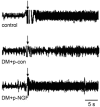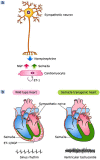Cardiac innervation and sudden cardiac death
- PMID: 21037846
- PMCID: PMC2842961
- DOI: 10.2174/157340309789317904
Cardiac innervation and sudden cardiac death
Abstract
The heart is extensively innervated and its performance is tightly controlled by the nervous system. Cardiac innervation density varies in diseased hearts leading to unbalanced neural activation and lethal arrhythmia. Diabetic sensory neuropathy causes silent myocardial ischemia, characterized by loss of pain perception during myocardial ischemia, which is a major cause of sudden cardiac death in diabetes mellitus (DM). Despite its clinical importance, the mechanisms underlying the control and regulation of cardiac innervation remain poorly understood.We found that cardiac innervation is determined by the balance between neural chemoattractants and chemorepellents within the heart. Nerve growth factor (NGF), a potent chemoattractant, is induced by endothelin-1 upregulation during development and is highly expressed in cardiomyocytes. By comparison, Sema3a, a neural chemorepellent, is highly expressed in the subendocardium of early stage embryos, and is suppressed during development. The balance of expression between NGF and Seme3a leads to epicardial-to-endocardial transmural sympathetic innervation patterning. We also found that downregulation of cardiac NGF leads to diabetic neuropathy, and that NGF supplementation rescues silent myocardial ischemia in DM. Cardiac innervation patterning is disrupted in Sema3a-deficient and Sema3a-overexpressing mice, leading to sudden death or lethal arrhythmias. The present review focuses on the regulatory mechanisms underlying cardiac innervation and the critical role of these processes in cardiac performance.
Keywords: Cardiac nerve; Sema3a; arrhythmia; nerve growth factor; silent myocardial ischemia; sudden cardiac death..
Figures





Similar articles
-
Regulation of cardiac nerves: a new paradigm in the management of sudden cardiac death?Curr Med Chem. 2008;15(17):1731-6. doi: 10.2174/092986708784872339. Curr Med Chem. 2008. PMID: 18673222 Review.
-
New aspects for the treatment of cardiac diseases based on the diversity of functional controls on cardiac muscles: the regulatory mechanisms of cardiac innervation and their critical roles in cardiac performance.J Pharmacol Sci. 2009 Mar;109(3):348-53. doi: 10.1254/jphs.08r25fm. Epub 2009 Mar 7. J Pharmacol Sci. 2009. PMID: 19270423 Review.
-
Nerve growth factor is critical for cardiac sensory innervation and rescues neuropathy in diabetic hearts.Circulation. 2006 Nov 28;114(22):2351-63. doi: 10.1161/CIRCULATIONAHA.106.627588. Epub 2006 Nov 13. Circulation. 2006. PMID: 17101855
-
Sema3a maintains normal heart rhythm through sympathetic innervation patterning.Nat Med. 2007 May;13(5):604-12. doi: 10.1038/nm1570. Epub 2007 Apr 8. Nat Med. 2007. PMID: 17417650
-
Development, maturation, and transdifferentiation of cardiac sympathetic nerves.Circ Res. 2012 Jan 20;110(2):325-36. doi: 10.1161/CIRCRESAHA.111.257253. Circ Res. 2012. PMID: 22267838 Review.
Cited by
-
X-ray Radiotherapy Impacts Cardiac Dysfunction by Modulating the Sympathetic Nervous System and Calcium Transients.Int J Mol Sci. 2024 Aug 31;25(17):9483. doi: 10.3390/ijms25179483. Int J Mol Sci. 2024. PMID: 39273430 Free PMC article.
-
Molecular and cellular neurocardiology in heart disease.J Physiol. 2025 Mar;603(7):1689-1728. doi: 10.1113/JP284739. Epub 2024 May 22. J Physiol. 2025. PMID: 38778747 Review.
-
The Adaptor Protein CD2AP Is a Coordinator of Neurotrophin Signaling-Mediated Axon Arbor Plasticity.J Neurosci. 2016 Apr 13;36(15):4259-75. doi: 10.1523/JNEUROSCI.2423-15.2016. J Neurosci. 2016. PMID: 27076424 Free PMC article.
-
Semaphorin 3A attenuates cardiac autonomic disorders and reduces inducible ventricular arrhythmias in rats with experimental myocardial infarction.BMC Cardiovasc Disord. 2016 Jan 19;16:16. doi: 10.1186/s12872-016-0192-8. BMC Cardiovasc Disord. 2016. PMID: 26787044 Free PMC article.
-
Hypertension-induced heart failure disrupts cardiac sympathetic innervation.Am J Physiol Heart Circ Physiol. 2024 Dec 1;327(6):H1544-H1558. doi: 10.1152/ajpheart.00380.2024. Epub 2024 Nov 1. Am J Physiol Heart Circ Physiol. 2024. PMID: 39485300
References
-
- Cao JM, Chen LS, KenKnight BH, et al. Nerve sprouting and sudden cardiac death. Circ Res. 2000;86:816–21. - PubMed
-
- Kaye DM, Vaddadi G, Gruskin SL, Du XJ, Esler MD. Reduced myocardial nerve growth factor expression in human and experimental heart failure. Circ Res. 2000;86:E80–4. - PubMed
-
- Cao JM, Fishbein MC, Han JB, et al. Relationship between regional cardiac hyperinnervation and ventricular arrhythmia. Circulation. 2000;101:1960–9. - PubMed
-
- Chen LS, Zhou S, Fishbein MC, Chen PS. New perspectives on the role of autonomic nervous system in the genesis of arrhythmias. J Cardiovasc Electrophysiol. 2007;18:123–7. - PubMed
-
- Chen PS, Chen LS, Cao JM, Sharifi B, Karagueuzian HS, Fishbein MC. Sympathetic nerve sprouting, electrical remodeling and the mechanisms of sudden cardiac death. Cardiovasc Res. 2001;50:409–16. - PubMed
LinkOut - more resources
Full Text Sources

